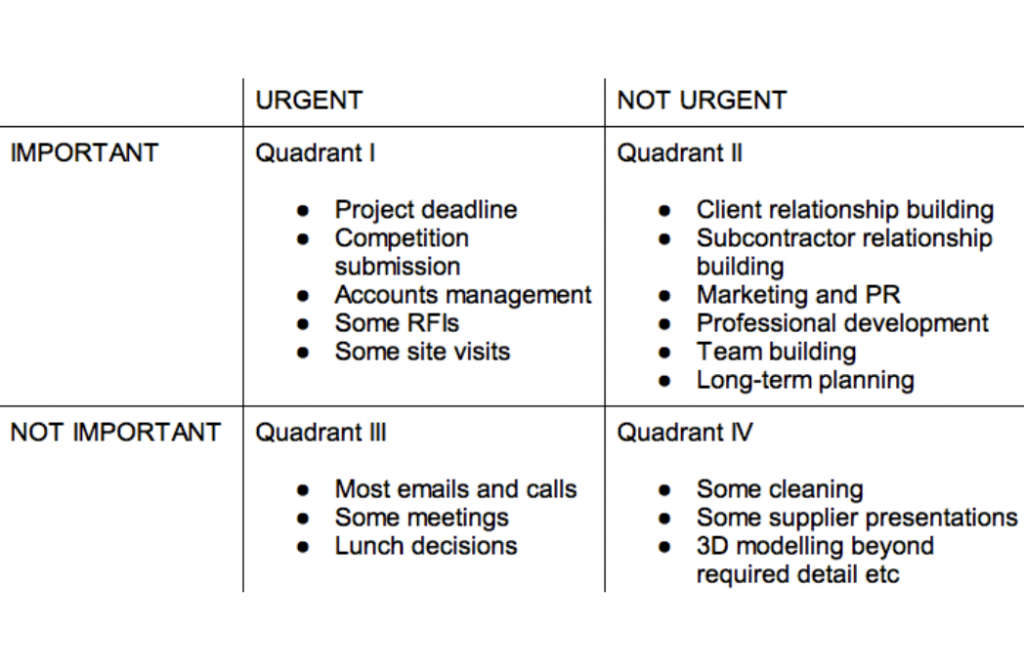
The seven habits of highly effective architects – part three
The seven habits of highly effective architects – part three
Share
Effective habits are internalised principles and patterns of behaviour that assist us to perform at our best. The third in the series...
Habit 3 – Put first things first
Put first things first. Sounds simple, right? But what is the most important thing you could do when you arrive at work? And is that the thing that you do? Before you start attacking your weekly tasks they should be prioritised around your greater goals and values. This is different to simply being busy throughout the week and getting ‘things’ done.
Habit 3 is the physical creation of the vision laid out in Habit 2. This is where you breakdown your weekly and daily tasks against your values and goals. This is an action oriented habit. This is about setting up tasks using a value-based hierarchy and then doing them.
Value-based priorities
“The key is not to prioritise what’s on your schedule, but to schedule your priorities.” Stephen R Covey.
It is all too common for values and objectives to be set, only to find that the daily demands of work and life take over. As a result, the goals remain elusively out of reach. In order to achieve your personal and professional objectives you need to progress them on a daily and weekly basis. This is not about doing more, or fitting more into the day. This is about doing more of the right things that take you closer to where you want to be.
Stukel Architecture is a Sydney-based studio that has been consistently progressing the vision of the practice over many years. Stukel’s projects are idiosyncratic and they all have a very personal story to tell. The practice strives to help clients fulfil a major creative outcome in their own lifetime. Stukel Architecture director, Daniel Beasly says, “We workshopped with the team and asked the big scary question: ‘What’s the point?’ And we came up with something that everyone felt good about.”
In order to translate this vision into action, Stukel Architecture uses value-based prioritisation to ensure that the right tasks are being undertaken.This alignment of the vision and end goals (Habit 2) is the foundation to enable the team to then sort through the tasks to ensure that the vision is being actively progressed on a daily basis. “We often discuss among ourselves to gain an agreed position on what is urgent and what is important. We feel that nothing should ever be a crisis or panic – and if there is it’s often a sign that there is a misalignment. The urgent things I find are often driven by someone else’s personal agenda and are often not aligned to the visions of the project or the firm.”
A time management tool
The time management matrix shown in the diagram below is a powerfully straightforward tool to assist with value-based prioritisation. To use this tool, first jot down all the items that need your attention, including those important tasks that you should be working on, but rarely find time for. With all tasks and activities accounted for, you can begin to place them into their corresponding quadrants in the matrix.

The matrix is centred on two factors: important and urgent. ‘Urgent’ is the stuff that grabs our attention – the email from a builder that puts pressure on you for a response. ‘Urgent’ is also the deadline for a project: something that must be met. ‘Important’ are the things that align to your values – the things that, if done well, will contribute to you moving along the correct path to your personal and professional end goals. Many of the things that are important to achieving your long-term success are not urgent and, as a result, often get neglected. Things like client relationship building, marketing and team training. This tool helps you to prioritise these valuable activities.
The quadrants are numbered in hierarchical order. By spending as much time as possible working on tasks in quadrants 1 and 2 you will ensure that you are continuing to progress your mission and long-term goals.
Better not busier
“The essence of the best thinking in the area of time management can be captured in a single phrase: organise and execute around priorities.” Stephen R Covey.
Busy people rarely say no, busy people fear letting people down, and most of us from time to time fall into the busy trap. Remember, the aim is not to do more, but to do more of the activities that matter. Prioritisation and organisation of tasks can supercharge your output and propel you toward your end goals. Even a single day of executing tasks using value-based prioritisation has the ability to keep you aligned and, ultimately, achieve more.
Top image: Flowstate by Stukel Architecture © Gregg Minns Photography
This article first appeared in AR163.
















